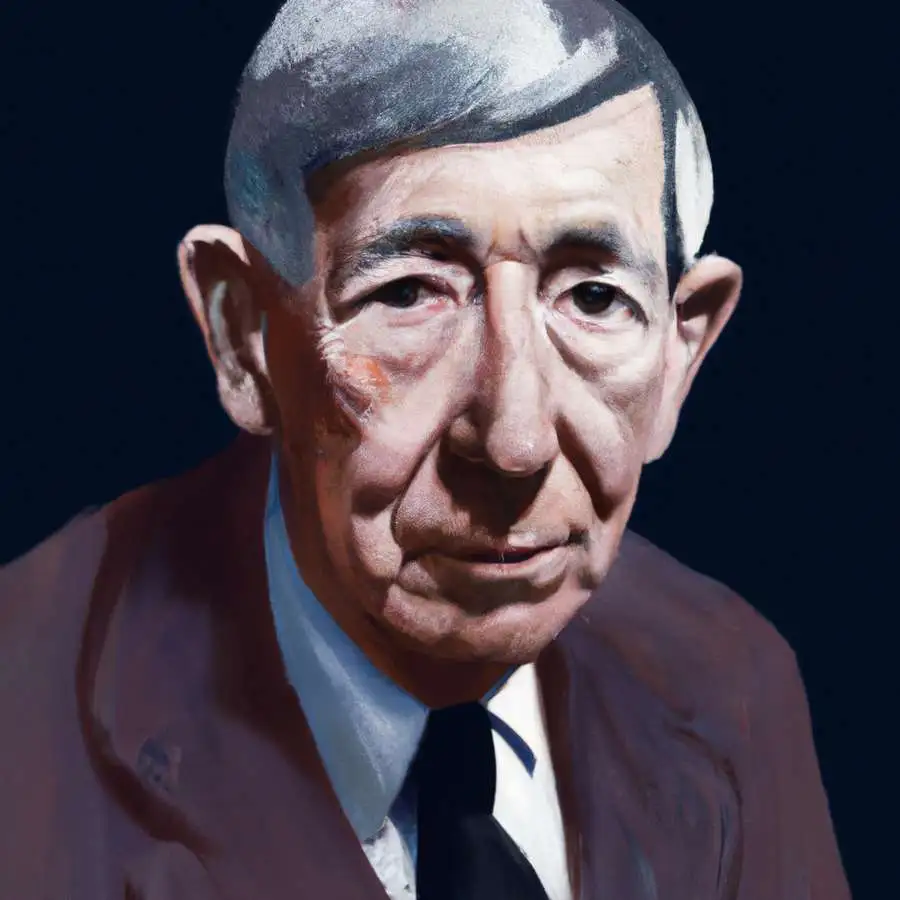John Updike: The Prolific Penman and Chronicler of American Life
John Updike (1932-2009) was an acclaimed American author, poet, and literary critic known for his prolific output and insightful explorations of American life. Born on March 18, 1932, in Shillington, Pennsylvania, Updike’s literary career spanned over five decades, during which he produced numerous novels, short stories, essays, poetry collections, and criticism. His work garnered critical acclaim, earning him numerous awards and establishing him as one of the most important figures in contemporary American literature.

Updike grew up in a small town in Pennsylvania, where his early experiences would later serve as inspiration for his fictional works. He developed a passion for writing at a young age and excelled in his studies, eventually earning a scholarship to Harvard University. At Harvard, Updike honed his writing skills and contributed to the Harvard Lampoon, the university’s renowned humor magazine. After graduating in 1954 with a degree in English, he pursued a career in writing.
In 1955, Updike’s first published story, “Friends from Philadelphia,” appeared in The New Yorker, a magazine with which he would maintain a long and fruitful relationship. This early success set the stage for his subsequent literary endeavors. In 1959, he published his first novel, “The Poorhouse Fair,” which received favorable reviews but did not gain significant commercial success.
However, Updike’s breakthrough came with his novel “Rabbit, Run” in 1960, which introduced readers to his most famous character, Harry “Rabbit” Angstrom. The book garnered critical acclaim for its vivid portrayal of post-war American society and Rabbit’s struggle with personal and societal expectations. Updike continued Rabbit’s story in three more novels: “Rabbit Redux” (1971), “Rabbit Is Rich” (1981), and “Rabbit at Rest” (1990). The Rabbit series, often referred to as the Rabbit tetralogy, solidified Updike’s place as a master chronicler of American life.
Some trivia facts about John Updike, the The Prolific Penman:
- Prolific Writer: Throughout his career, John Updike wrote more than 60 books, including novels, short story collections, poetry collections, essays, and literary criticism. His remarkable output and versatility as a writer contributed to his enduring impact on American literature.
- The Rabbit Series: Updike’s Rabbit Angstrom tetralogy, consisting of the novels “Rabbit, Run,” “Rabbit Redux,” “Rabbit Is Rich,” and “Rabbit at Rest,” earned him widespread acclaim and recognition. The series follows the life of the character Harry “Rabbit” Angstrom, exploring themes of suburban life, personal struggles, and the changing landscape of post-war America.
- Pulitzer Prize Winner: John Updike received the prestigious Pulitzer Prize for Fiction twice in his career. He won the award for “Rabbit Is Rich” in 1982 and for “Rabbit at Rest” in 1991. The Pulitzer Prizes recognized his exceptional storytelling, keen observations, and insightful exploration of American society.
- Updike and The New Yorker: Updike had a long-standing relationship with The New Yorker, one of the most esteemed literary magazines. His first published story, “Friends from Philadelphia,” appeared in The New Yorker in 1955, and he continued to contribute to the magazine throughout his career. His association with The New Yorker helped establish his reputation as a prominent literary figure.
- Literary Critic: In addition to his fiction writing, Updike was highly regarded as a literary critic and essayist. He wrote thought-provoking essays and criticism on a wide range of topics, including literature, art, and culture. His essays appeared in prestigious publications such as The New Yorker and The New York Review of Books, showcasing his insightful analysis and deep understanding of the written word.
- Golf Enthusiast: Updike was an avid golfer, and his passion for the sport often found its way into his writing. Golf served as a metaphor in some of his works, symbolizing life’s challenges and the pursuit of personal fulfillment. Updike’s love for golf was not just limited to his writing—he actively played the sport and even wrote a book on the subject called “Golf Dreams: Writings on Golf.”
- National Humanities Medal: In 2003, John Updike was honored with the National Humanities Medal, which recognizes individuals or organizations that have made significant contributions to the humanities in the United States. The award acknowledged Updike’s profound impact on American literature and his exploration of the human condition through his writing.

Throughout his career, Updike published more than 60 books, including novels, short story collections, poetry collections, and essays. His works explored a wide range of themes, from the complexities of human relationships and suburban life to religion, art, and American identity. His writing was known for its meticulous attention to detail, rich imagery, and insightful observations of everyday life.
In addition to his fiction, Updike was also a skilled literary critic and essayist. He wrote thought-provoking essays on a variety of topics, including literature, art, and culture. His literary criticism often appeared in prestigious publications such as The New Yorker and The New York Review of Books, further establishing his reputation as a versatile and influential writer.
Throughout his career, Updike received numerous accolades and awards. He won the Pulitzer Prize for Fiction twice, first for “Rabbit Is Rich” in 1982 and then for “Rabbit at Rest” in 1991. He was also a recipient of the National Book Award, the National Book Critics Circle Award, and the PEN/Faulkner Award. In 2003, Updike received the National Humanities Medal from President George W. Bush in recognition of his contributions to American literature.
List of works by John Updike in chronological order:
- “The Carpentered Hen and Other Tame Creatures” (1958) – Poetry collection
- “The Poorhouse Fair” (1959) – Novel
- “Rabbit, Run” (1960) – Novel
- “Pigeon Feathers and Other Stories” (1962) – Short story collection
- “The Centaur” (1963) – Novel
- “Of the Farm” (1965) – Novel
- “The Music School” (1966) – Novel
- “The Poorhouse Fair” (1966) – Revised edition
- “Couples” (1968) – Novel
- “The Carpentered Hen” (1970) – Revised edition of “The Carpentered Hen and Other Tame Creatures”
- “Bech: A Book” (1970) – Novel
- “Rabbit Redux” (1971) – Novel
- “Marry Me” (1976) – Novel
- “Tossing and Turning: Poems” (1977) – Poetry collection
- “The Coup” (1978) – Novel
- “Rabbit Is Rich” (1981) – Novel
- “The Witches of Eastwick” (1984) – Novel
- “Roger’s Version” (1986) – Novel
- “S.” (1988) – Novel
- “Rabbit at Rest” (1990) – Novel
- “Odd Jobs: Essays and Criticism” (1991) – Non-fiction collection
- “Memories of the Ford Administration” (1992) – Novel
- “Collected Poems: 1953-1993” (1993) – Poetry collection
- “Brazil” (1994) – Novel
- “In the Beauty of the Lilies” (1996) – Novel
- “Toward the End of Time” (1997) – Novel
- “Bech at Bay” (1998) – Novel
- “Gertrude and Claudius” (2000) – Novel
- “Seek My Face” (2002) – Novel
- “The Early Stories: 1953-1975” (2003) – Short story collection
- “Villages” (2004) – Novel
- “Still Looking: Essays on American Art” (2005) – Non-fiction collection
- “Terrorist” (2006) – Novel
- “Due Considerations: Essays and Criticism” (2007) – Non-fiction collection
- “The Widows of Eastwick” (2008) – Novel
- “Endpoint and Other Poems” (2009) – Poetry collection (published posthumously)
- “My Father’s Tears and Other Stories” (2009) – Short story collection (published posthumously)
Beyond his literary achievements, Updike led a relatively private personal life. He was married twice and had four children. He lived for many years in Ipswich, Massachusetts, which became the setting for some of his novels. Updike was an avid golfer and incorporated his passion for the sport into his writing, often using golf as a metaphor for life and its challenges.
John Updike passed away on January 27, 2009, at the age of 76.
Reviews of works by John Updike
Gertrude and Claudius
Into Shakespearean Lore: Exploring “Gertrude and Claudius” by John Updike My Thoughts on Gertrude and…
The Witches of Eastwick
“The Witches of Eastwick” by John Updike: A Bewitching Blend of Fantasy and Feminism John…
Rabbit Is Rich
A Riveting Tale of Ambition, Love, and Midlife Reflection – John Updike’s “Rabbit Is Rich”…
Rabbit Redux
An Intense Journey of Personal Turmoil – “Rabbit Redux” by John Updike John Updike, the…
Rabbit, Run
John Updike Rabbit, Run: An Exploration of Existential Turmoil and Suburban Discontent My Thoughts on…
Couples
Exploring Love and Struggles: A Deep Dive into “Couples” by John Updike My Take Aways…





